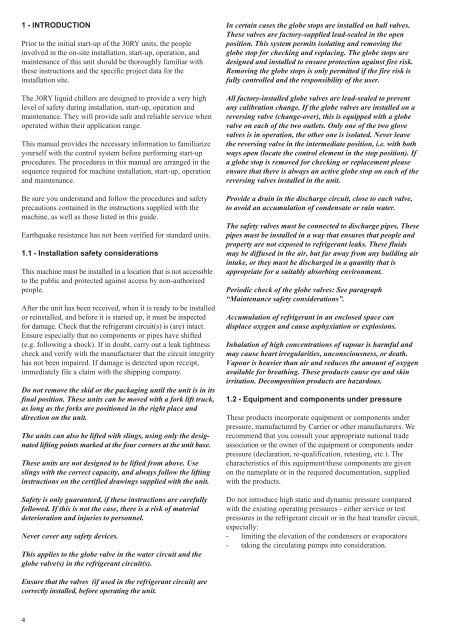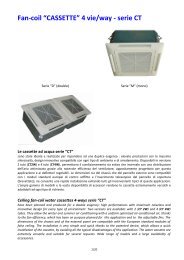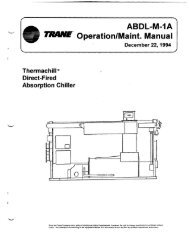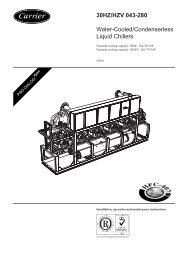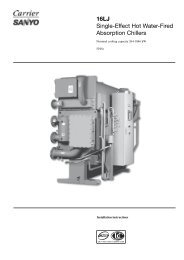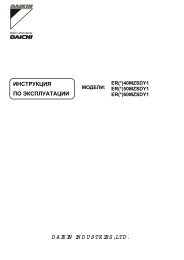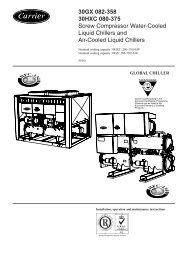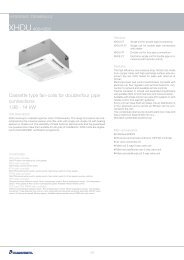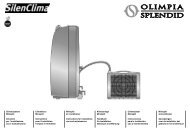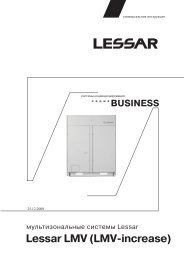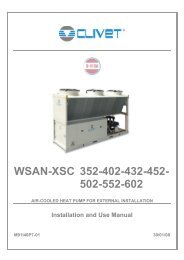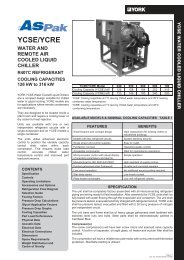"A" Ductable Liquid Chillers with Integrated Hydronic Module
"A" Ductable Liquid Chillers with Integrated Hydronic Module
"A" Ductable Liquid Chillers with Integrated Hydronic Module
You also want an ePaper? Increase the reach of your titles
YUMPU automatically turns print PDFs into web optimized ePapers that Google loves.
1 - INTRODUCTIONPrior to the initial start-up of the 30RY units, the peopleinvolved in the on-site installation, start-up, operation, andmaintenance of this unit should be thoroughly familiar <strong>with</strong>these instructions and the specific project data for theinstallation site.The 30RY liquid chillers are designed to provide a very highlevel of safety during installation, start-up, operation andmaintenance. They will provide safe and reliable service whenoperated <strong>with</strong>in their application range.This manual provides the necessary information to familiarizeyourself <strong>with</strong> the control system before performing start-upprocedures. The procedures in this manual are arranged in thesequence required for machine installation, start-up, operationand maintenance.Be sure you understand and follow the procedures and safetyprecautions contained in the instructions supplied <strong>with</strong> themachine, as well as those listed in this guide.Earthquake resistance has not been verified for standard units.1.1 - Installation safety considerationsThis machine must be installed in a location that is not accessibleto the public and protected against access by non-authorisedpeople.After the unit has been received, when it is ready to be installedor reinstalled, and before it is started up, it must be inspectedfor damage. Check that the refrigerant circuit(s) is (are) intact.Ensure especially that no components or pipes have shifted(e.g. following a shock). If in doubt, carry out a leak tightnesscheck and verify <strong>with</strong> the manufacturer that the circuit integrityhas not been impaired. If damage is detected upon receipt,immediately file a claim <strong>with</strong> the shipping company.Do not remove the skid or the packaging until the unit is in itsfinal position. These units can be moved <strong>with</strong> a fork lift truck,as long as the forks are positioned in the right place anddirection on the unit.The units can also be lifted <strong>with</strong> slings, using only the designatedlifting points marked at the four corners at the unit base.These units are not designed to be lifted from above. Useslings <strong>with</strong> the correct capacity, and always follow the liftinginstructions on the certified drawings supplied <strong>with</strong> the unit.Safety is only guaranteed, if these instructions are carefullyfollowed. If this is not the case, there is a risk of materialdeterioration and injuries to personnel.Never cover any safety devices.This applies to the globe valve in the water circuit and theglobe valve(s) in the refrigerant circuit(s).In certain cases the globe stops are installed on ball valves.These valves are factory-supplied lead-sealed in the openposition. This system permits isolating and removing theglobe stop for checking and replacing. The globe stops aredesigned and installed to ensure protection against fire risk.Removing the globe stops is only permitted if the fire risk isfully controlled and the responsibility of the user.All factory-installed globe valves are lead-sealed to preventany calibration change. If the globe valves are installed on areversing valve (change-over), this is equipped <strong>with</strong> a globevalve on each of the two outlets. Only one of the two glovevalves is in operation, the other one is isolated. Never leavethe reversing valve in the intermediate position, i.e. <strong>with</strong> bothways open (locate the control element in the stop position). Ifa globe stop is removed for checking or replacement pleaseensure that there is always an active globe stop on each of thereversing valves installed in the unit.Provide a drain in the discharge circuit, close to each valve,to avoid an accumulation of condensate or rain water.The safety valves must be connected to discharge pipes. Thesepipes must be installed in a way that ensures that people andproperty are not exposed to refrigerant leaks. These fluidsmay be diffused in the air, but far away from any building airintake, or they must be discharged in a quantity that isappropriate for a suitably absorbing environment.Periodic check of the globe valves: See paragraph“Maintenance safety considerations”.Accumulation of refrigerant in an enclosed space candisplace oxygen and cause asphyxiation or explosions.Inhalation of high concentrations of vapour is harmful andmay cause heart irregularities, unconsciousness, or death.Vapour is heavier than air and reduces the amount of oxygenavailable for breathing. These products cause eye and skinirritation. Decomposition products are hazardous.1.2 - Equipment and components under pressureThese products incorporate equipment or components underpressure, manufactured by Carrier or other manufacturers. Werecommend that you consult your appropriate national tradeassociation or the owner of the equipment or components underpressure (declaration, re-qualification, retesting, etc.). Thecharacteristics of this equipment/these components are givenon the nameplate or in the required documentation, supplied<strong>with</strong> the products.Do not introduce high static and dynamic pressure compared<strong>with</strong> the existing operating pressures - either service or testpressures in the refrigerant circuit or in the heat transfer circuit,especially:- limiting the elevation of the condensers or evaporators- taking the circulating pumps into consideration.Ensure that the valves (if used in the refrigerant circuit) arecorrectly installed, before operating the unit.4


